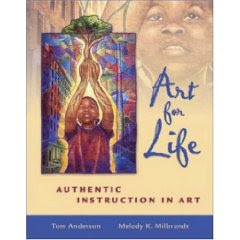“Although art teachers often teach about the formal qualities of art, they should be more concerned with its functions, including those that are political. Such a concern would show the power of art and make it more relevant to students.”
Definitions
“Historically, one thinks of prime political art examples to include Delacroix's Liberty Leading the People, Goya's The Third Day of May, Picasso's Guernica, and Rivera's murals (Von Blum, 1976). Students and teachers can find additional examples of political art by Courbet, Daumier, Beckman, Kollwitz, and Grosz in thematic art history texts such as those by Lewis and Lewis (1994) and Lazzari and Schlesier (2002).”
“Contemporary artists often express what some would call political points of view through their art, and the reader can see examples of this in the work of Lynne Hull (pollution), Fred Wilson (racism), and Jaune Quick-to-See Smith (unjust treatment of Native peoples).”
“While some teachers may not want to bother with the political analysis of art, Feldman (1978) stated that art is a catalyst that makes things happen, and he urged teachers to teach about the important ideas that artists try to communicate.”
Controversy
“Especially in conservative communities, teachers should be concerned with the possible ramifications of political art discussions, but this should not hinder their attempts to include them in a manner appropriate to students' understandings.”
“Smith (1996) implied that if teachers devoted more time to art's social concerns, then art instruction might be seen as useful and have a more secure place in the school curriculum.”
“In the last 50 years, Modem artists tried to assert their independence from powerful people and ordinary citizens, but lately Postmodern artists made art as if the world mattered (Gablik 1991, 1995).”
Related Literature
“Coles (1986) found that children have a developing awareness of many political issues, and teachers could provide opportunities for students to see the artistic and expressive applications of their knowledge.”
“…Kincheloe, Slattery, and Steinberg (2000)…emphasize contextualizing education by making meaningful connections between teaching and communities. Such a community concern is important to many contemporary and community-based artists.”
“Students should consider the significance of all visual imagery by looking at its ideology, source, and sponsorship (Duncum, 2002).”
“At a time when most teachers try to take into consideration the genetic and cultural differences of their students, it is important that they learn about the political art of multicultural artists whose work may call attention to special circumstances.”
“Viewers can find relevant examples in the work of Barbara Kruger, Yolanda Lopez, Robert Colescott, Michael Ray Charles, and Luis Jimenez.”
“…art by artists from previously colonized countries often refers to "invisible" cultures and acknowledges intersecting histories and streams of thought.”
“…when repressive government officials assert their will on the traditional values of citizens, the people often use folk art in protest to preserve their heritage (Zug, 1994).”
Classroom Applications
“1. To explore the implications of political art in schools, teachers need to help students investigate relevant and known historical and contemporary examples for reference and discussion.”
“Once students evaluate artworks that they can understand and appreciate, they should be encouraged to identify the political aspects of all art, including those that are more contemporary and of non-Western heritage.”
“2. For further discussion, art educators can find contemporary political art in many communities both here and abroad. Viewers often find that artists produce political art in countries where oppression, individual rights, and current events are of serious concern.”
“3. …teachers and students might look to their communities, homes, and local media to find further examples of art with political implications.”
“To see the political in art, teachers need to help students assess the objectives of artists and the effect of their art in the community.”
“4. Teachers can help students engage in the fabric of their communities through personal artistic responses (jagodzinski, 2001).”
“…through personal response to global concerns, students could explore many of the unresolved problems that we have previously encountered.”
“…art teachers could show students how they can have a voice in the community through art. To identify specific global or regional issues, teachers could help students analyze local newspaper headlines, editorial cartoons, and advertising imagery.”
“Through reflection, teachers could help students identify more personal and local topics of concern such as school or home violence, social isolation, oppressive policies, intolerance, limited student support, and stereotypical expectations.”
“This approach encourages students to look at environmental and social structures from multiple perspectives.”
Summary
“By analyzing art from a political point of view and encouraging students to think of the political aspects of their own work, art teachers can make both the presentation and production of art a more meaningful endeavor.”
Subscribe to:
Post Comments (Atom)






No comments:
Post a Comment